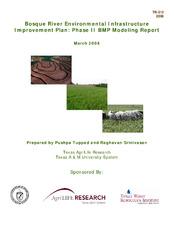| dc.description.abstract | The Bosque River Watershed is located in the Brazos River Basin in central Texas and is facing a suite of water quality issues resulting in sediment, nutrient and bacteria loading. These loadings are potentially derived from improperly managed cropland and grazing land, land-applied dairy waste, and effluent discharge from eight wastewater treatment plants. The first phase of the project developed an effective methodology for determining priority areas in the watershed where best management practice (BMP) implementation would likely yield the greatest improvements in water quality. The objectives of this project (Phase II) are to apply the Soil and Watershed Assessment Tool (SWAT) model to simulate and evaluate the impacts of implementing several best management practices (a) in the entire watershed, and (b) at incremental levels in high, medium, and low priority areas of the watershed, identified using three different impact indices.
Initially, the SWAT model was calibrated for long-term annual and monthly flow at a USGS gaging station located in the lower portion of the watershed for the period from 1980 through 2005 and was validated at the same location for the period 1960 through 1979. The model was also calibrated, at a monthly time step, for water quality parameters including sediment, organic and mineral nitrogen, and phosphorus at two locations, Hico and Valley Mills. Model performance statistics (coefficient of determination and Nash-Sutcliffe modeling efficiency) indicated that model performance was satisfactory and could be used for evaluating the impacts of alternative management scenarios to reduce nonpoint source pollution.
BMPs including streambank stabilization, gully plugs, recharge structures, conservation tillage, terraces, contour farming, grazing management, manure incorporation, edge-of-field filter strips, and PL-566 reservoirs were simulated as being implemented in the watershed areas that met the respective practice’s specific criteria for implementation. These BMPs were simulated individually and the resulting farm level (HRU level), subwatershed level, and watershed outlet level impacts were quantified for each BMP. Reductions in sediment load at the watershed outlet, as a result of implementing these BMPs individually, was as much as 37 percent while reductions in total nitrogen (TN) ranged from 1 percent to 24 percent and total phosphorus (TP) varied from a 3 percent increase to a 30 percent decrease. The 3 percent increase is indicative of conservation tillage and is likely caused by the lack of soil inversion and mixing, which yields an accumulation of dissolved (mineral) phosphorus in the soil’s surface layer. At subwatershed levels, reductions brought about by implementing the BMPs were relatively greater as compared to the watershed outlet reductions. Reductions in sediment were as high as 47 percent and reductions in TN and TP were 37 percent and 32 percent, respectively.
Subwatersheds were categorized into “high,” “medium,” and “low” priority based on calibrated simulation results. Considering sediment, TN, and TP (as pollutants), three types of total impact indices were estimated. The “Concentration Impact Index” is based on pollutant concentrations (SWAT output values extracted from the ‘reach output file’), considers contributions from the subwatershed as well as the entire upstream watershed, and is effective in determining priority areas for addressing localized pollution problems in low and high flow conditions. The “Load Per Unit Area Impact Index” is based on the total pollutant load coming from a specific area (SWAT output values extracted from the ‘subbasin output file’), considers contributions from an individual subwatershed, and is used to effectively assign a priority to each subwatershed. The “Load Impact Index” is based on pollutant loads from subwatersheds and upstream areas (SWAT output values extracted from the ‘reach output file’) and portrays the cumulative effects of pollutant loading throughout the entire watershed.
Priority areas in the watershed varied based on which impact index was used in the evaluation; therefore, the areas where BMP implementations were evaluated differed between simulations. Despite varying BMP implementation sites, all BMPs were modeled incrementally, first on high priority subwatersheds followed by medium and low priority subwatersheds. BMPs considered for implementing in prioritized subwatersheds included streambank stabilization, recharge structures, conservation tillage, terracing, grazing management, and manure incorporation. When comparing the reductions achieved from implementation of BMPs using the three impact indices, load per unit area criteria typically yielded higher pollutant reductions. This outcome is likely a result of the majority of BMPs simulated in this study addressing upland pollutant reductions rather than in-stream reductions. Therefore, these BMPs resulted in larger pollutant reductions because they targeted local upland areas that typically generate higher pollutant loads. Implementing these BMPs in the entire watersheds resulted in sediment, TN, and TP load reductions of 73 percent, 43 percent, and 68 percent, respectively. | en |


